A closer look at some COVID-19 trends behind re-opening Indiana: Monroe County in statewide context
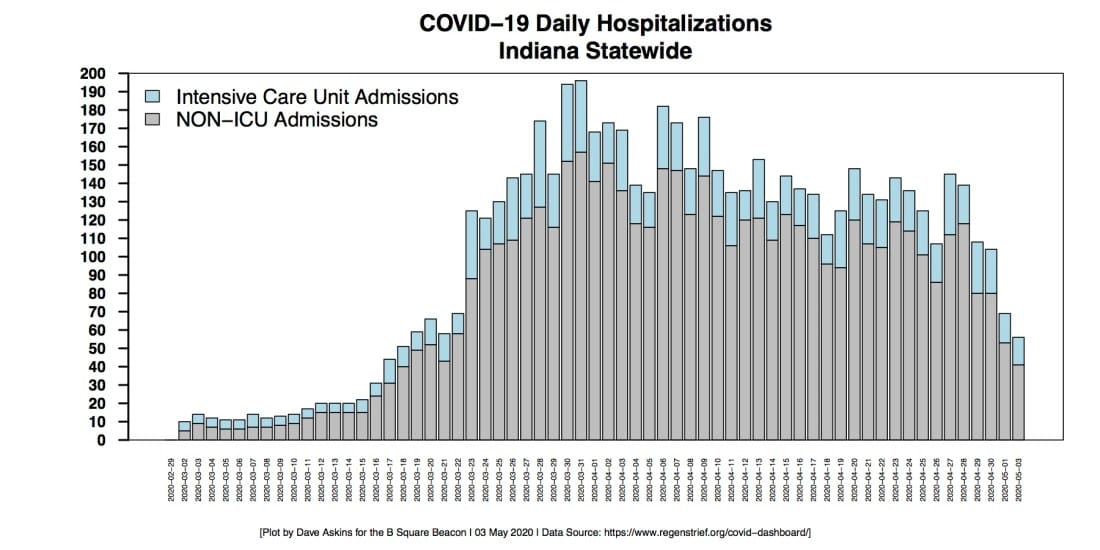

When Bloomington’s mayor, John Hamilton, gave his state of the city address on Feb. 20, just 15 cases of the COVID-19 virus were confirmed nationwide, none of them in the Hoosier state.
Now two and a half months later, 1,132 residents of Indiana have died of COVID-19, out of about 20,000 confirmed cases.
In Monroe County, the count of COVID-19 deaths stands at 8, out of a total of 130 confirmed positive cases. Of the eight Monroe County deaths, three are female, one male and one is unknown. Four were between 70 and 79 years old, three were older than 80, and one was 50 to 59. All eight were White.
An economic shutdown prompted by COVID-19 began with Indiana governor Eric Holcomb’s “Hunker-Down, Hoosiers” order six weeks ago, on March 25.
Now most of the state is preparing for a partial emergence from that shutdown on the morning of Monday May 4.
Under Holcomb’s Friday order, most of the state will see all retail stores allowed to open on Monday at 50 percent of their occupational capacity. Under Holcomb’s order, a week later, on May 11, restaurants would be allowed to open for dine-in service at 50 percent of their seating capacity. The governor’s order includes a series of phases that lead to a mostly complete re-opening by July 4.
But Monroe County health officials, with support from other government leaders, are using their option to keep the county buttoned up a bit longer.
The COVID-19 public health order issued on Friday puts the county’s residents under the same stay-at-home order as before, until May 15. Counties are allowed to exercise that discretion under the county-by-county approach in the governor’s order.
Even as Monroe County’s COVID-19 numbers are currently trending better than statewide, the county’s order signed by Monroe County’s health officer Thomas Sharp on Friday concludes that “Locally, data and our public health indicators do not show we are meeting the gating criteria set forth by the Centers for Disease Control…”
The CDC “gating criteria” criterion that Monroe County fails to meet involves a robust testing program that’s supposed to place for at-risk healthcare workers, including emerging antibody testing and contact tracing, according to the county’s health administrator, Penny Caudill.
Monroe County ranks 65th out of 92 counties in the per capita number of COVID-19 tests that have been done. The 1,327 tests that have been performed in the county translate to about 89 out of every 10,000 residents. Cass County, where there was an outbreak in a meat-packing plant, leads with 617 tests per 10,000 residents.
For the other gating criteria, Monroe County’s trends look better than the statewide numbers. One of the gating criteria is a downward trajectory of documented cases within a 14-day period. Statewide, the daily trend has been roughly steady for the last 14-days. But there’s not a clear downward trajectory.
That’s also true if the numbers are run statewide, leaving out the three counties that Holcomb is putting on a slower re-start schedule. Monroe County, in contrast has averaged a little more than a case a day for the last 14 days. The daily average for the previous 14 days was about 5 confirmed cases.
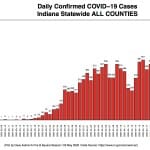
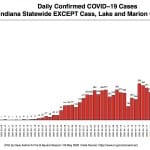
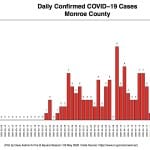
As an alternative to the downward trajectory in confirmed COVID-19 cases, the gating criteria say that a decreasing trend in the percentage of tests that come back positive can also qualify a region for re-opening. Statewide, the trend for the last few weeks has been mostly stable—if there’s a trend then it’s slightly upward. For Monroe County, though, the percentage of positive tests has gradually dropped from 13 percent two weeks ago to about 10 percent.
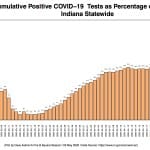
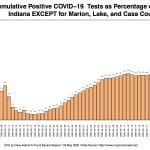
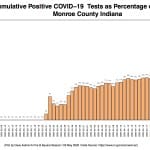
Even though Monroe County looks solid on those gating criteria, local health officials are waiting to confirm that another requirement—robust testing and contact tracing—is satisfied, before they start opening up the county.
Caudill pointed out that by mid-May enhanced testing would be provided in Monroe County by OptumServe Health Services—as many as 132 tests a day. Up to now, Monroe County has ranged between 30 and 60 tests a day.
Also available in mid-May, Caudill said, would be support from a partnership the state has announced with Maximus, to centralize contact tracing and investigations. It includes the hire of 500 people and setting up a call center. Contact tracing is key to curbing the spread of the virus, because it ensures that people who’ve been in contact with people who tested positive are notified, so they can isolate themselves.
Assuming the number of cases has not reversed its downward trend, by mid-May the enhanced testing capability could put Monroe County on a path to re-opening. On Friday, Caudill said the her department would continue to monitor the situation. She held out the possibility that Monroe County could eventually join the governor’s timeline instead of maintaining a separate timetable into the indefinite future.
A social media study reported by Forbes is forecasting a spike in COVID-19 for Monroe County. But that doesn’t seem to have been a big factor in local decision making. It’s not mentioned in Friday’s order. Still, county officials are aware of the study. President of Monroe County’s board of commissioners, Julie Thomas, mentioned it during Friday’s weekly press conference.
Why is Holcomb being less conservative than Monroe County officials? Based on Friday’s press conference, a key for Holcomb is the statewide satisfaction of another gating criterion—the ability of hospitals to treat all patients without using a crisis standard of care. That means that patients can be treated without a substantial change in usual healthcare operations.
The state has shown a discernible downward trend in hospital admissions—for intensive care units and non-ICU units, alike—over the last couple of weeks. Even as the number of COVID-19 cases seems to be steady, the severity of those cases seems to be less.
A decline is severity of cases is something that Brian Shockney, president of IU Health’s South Central Region, confirmed at Friday’s weekly press conference of local government officials.
Shockney said the decline in severity of cases is not steep—IU Health still has a lot of patients on ventilators, he said. The pattern is more of a “sawtooth” trend, he said. “We’re not out of the woods, yet,” Shockney concluded.
Statewide, at week’s end, 44 percent of ICU beds and 80 percent of ventilators were available to treat additional COVID-19 patients. IU Health had 43 percent of its ICU beds and 68 percent of ventilators available.
With Holcomb’s phase-wise lifting of the shutdown came a recognition that the state would see additional COVID-19 cases and deaths. The first question asked at the press conference involved the balance of lives versus a return to normal life.

“What was the point of the stay-at-home order?” asked a reporter. She continued: “If we know that we are going to see an increase in cases, if we know as a result of reopening the economy that we are likely to see an increase in deaths—was the point to build in hospital capacity, or was it to preserve life?”
Holcomb’s response:
Well, we’ve always said that we wanted to be in the position to be able to care for anyone that has been adversely affected by COVID-19. The whole point, to answer your question directly, is to make sure that we have the ability to do that and the resources to do that. … Unfortunately, we’re gonna lose people all over the world—[even if] you can you can lock down the whole thing. So our effort going forward will be all about managing through this crisis. I’m praying for a vaccine, but we gotta do what we can do right now and we’re taking the responsible steps and allowing folks to responsibly and safely return to some normal aspects of their life.
How COVID-19 Cases in Indiana Have Spread

![]()




Comments ()